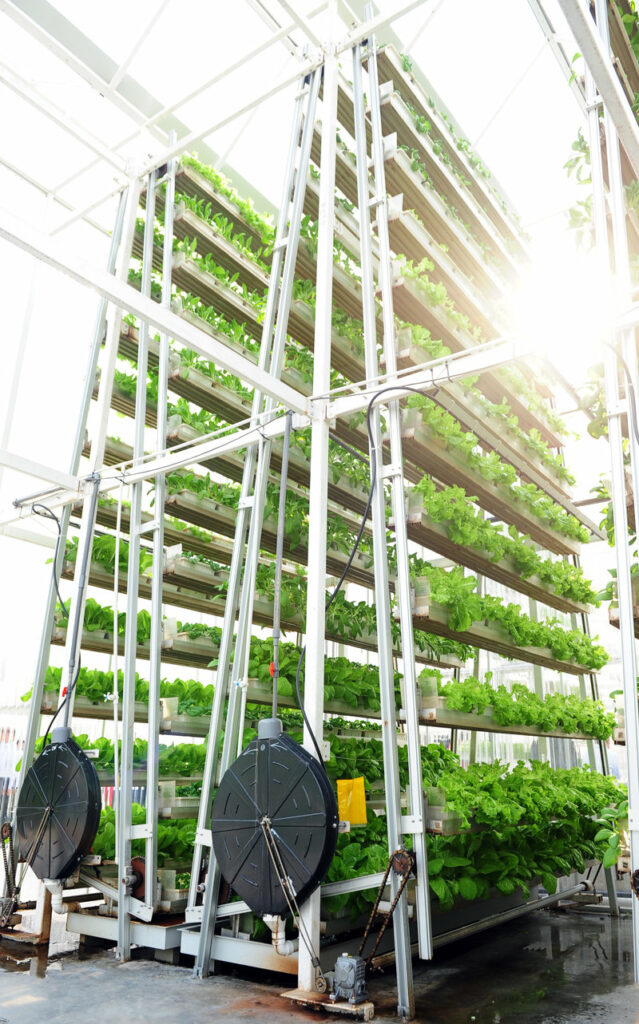For example “Nation’s Largest Indoor Vertical Farm, Opens In Chicago Area” (The Huffington Post) or “First Vertical Farm Opens in Singapore” (Wired.com/Design).
And with the vivid images of lush, green basil plants and bok choy growing up to the sky, it’s easy to see why these futuristic farms are making headlines.
They’re gorgeous, right?
Something about that vivid green color just draws you in and delights the eye.
For many outside of the urban farming or backyard gardening world, this may be extra appealing because they don’t get to see food being grown very often.
If you didn’t notice, there’s a real disconnect for most of our country as to where our food comes from.
So when we think about these “vertical farms” in the context of our current food culture, it’s no surprise they’re so popular!
BUT, are they really vertical farms?
“Vertical Farming” vs. “Farming Vertically”
We’re very excited to see commercial farmers start being more efficient with their available growing space. We’re big supporters of more sustainable agricultural practices, especially when they strive to do good!
In this case, “doing good” means feeding people healthier, more localized produce options. We think that’s an admirable venture in any case.
Merely stacked traditional horizontal hydroponic or aquaponic farming methods on top of one another is NOT a fundamental shift in production technique, but instead an alternate way to organize for traditional (old) techniques.
This differs in fact from truly vertical farming which takes an entirely original look at the idea of growing crops volumetrically, completely discarding the old guard definition of farming.
So… What is Vertical Farming?
True vertical farming confronts the challenges of traditional horizontal production by designing systems to:
- Be more efficient with time and limited [economic and environmental] resource by growing more in a smaller space yet incurring smaller infrastructure costs, energy costs and eliminating most post-harvest labor/packaging;
- Be more ergonomic and conducive to the needs of the farmer/laborers ensuring faster and easier planting and harvesting;
- Be more energy efficient and have less impact on both the farmer’s bottom line and the world around us.
In all, true vertical farming insists on starting with design to promote universal sustainability (i.e. sustaining the local communities farmers serve by relying on fewer natural resources to grow, harvest and transport healthier food which in turn sustains the farmer’s livelihood and our collective environmental resources).
Vertical farming differs from farming vertically in a few ways…
Infrastructure Investment
Farming vertically, that is, using stacked beds or NFT (nutrient film technique) requires much more intensity than vertical farming.
For one, the infrastructure itself often requires massive investment because of the sheer loads these systems accumulate when stacked vertically.
Contrary to that, true vertical farming technique designs often approach volumetric space-based growing from the ground up.
For instance, when designing our ZipGrow Towers, we looked at several different components necessary for productive, energy efficient and cost effective farming.
You see, ZipGrow™ Towers are designed to be light weight as to reduce the cost of support infrastructure and enable farmers to easily plant, maintain and transport towers live to market.
Not only does this enable a whole host of other benefits (e.g. live sales) it also reduces the time it takes to harvest a farmer’s crops, leading us into the next difference between vertical farming and farming vertically.
Harvesting Efficiency
Farming vertically with stacked beds, NFT troughs or even rotating carousels like the farm in Singapore often require a great deal of human labor to plant, tend and harvest the crops.
These designs either require more mechanical energy (e.g. Singapore’s Sky Greens Farm) or more human energy to crawl into tighter places in order to effectively tend and harvest crops.
Vertical farming, when designed with common issues in mind, can bypass them altogether granting the farmer a more ergonomic and efficient means of planting, tending and harvesting.
Energy Efficiency
Traditional horizontal techniques, at least in the northern hemisphere, often require supplemental lighting to produce uniform, salable crops.
It goes without saying that indoor growing requires massive investments in supplemental lighting, which of course require more energy no matter how efficient your bulbs are. This type of operational cost is far from practical for the small producer just starting out and can often pose installation challenges as well leading to more frustration and recurring expenses.
And of course when introducing mechanical carousels to equally provide light to plants also requires a grower to have more energy expenses penciled permanently into their budget.
True vertical farming can combat these challenges from the start and implement designs that utilize all natural light and eliminate light extinction. This in turn reduces a farmer’s energy expenses and helps him grow more in his space.
While these techniques are miles apart, vertical farming and farming vertically are not so different…
As different as vertical farming and farming vertically techniques are, they have a lot in common too.
For one, they are both ways of trying to localize production of food and serve more localized communities with fresher, healthier produce.
Second, they are both in response to the challenges and strains put on traditional agriculture practices (e.g. soil degradation and loss of arable land, sprawling cities, and massive transportation costs).
We are excited about the steps more and more producers are taking towards providing customers a higher quality product and feel encouraged to be a major part in the fresh food revolution!
Congrats to FarmedHere and Sky Green Farms for taking that first step towards more sustainable agriculture.






